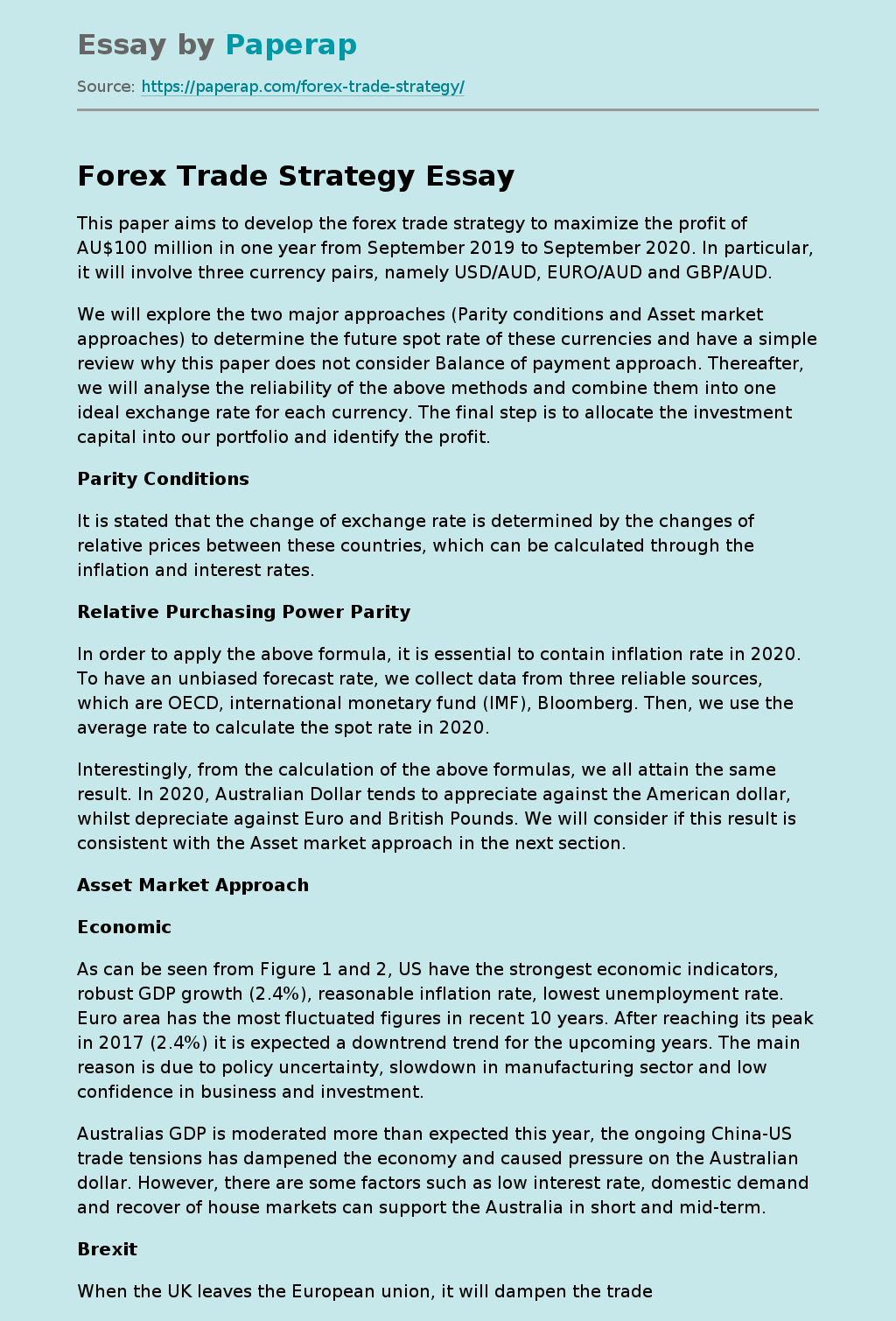Forex Trade Strategy
The following sample essay on “Forex Trade Strategy” aims to develop the forex trade strategy to maximize the profit of AU$100 million in one year from September 2019 to September 2020. In particular, it will involve three currency pairs, namely USD/AUD, EURO/AUD and GBP/AUD.
We will explore the two major approaches (Parity conditions and Asset market approaches) to determine the future spot rate of these currencies and have a simple review why this paper does not consider Balance of payment approach.
Thereafter, we will analyse the reliability of the above methods and combine them into one ideal exchange rate for each currency. The final step is to allocate the investment capital into our portfolio and identify the profit.
Parity Conditions
It is stated that the change of exchange rate is determined by the changes of relative prices between these countries, which can be calculated through the inflation and interest rates.
Relative Purchasing Power Parity
In order to apply the above formula, it is essential to contain inflation rate in 2020.
To have an unbiased forecast rate, we collect data from three reliable sources, which are OECD, international monetary fund (IMF), Bloomberg. Then, we use the average rate to calculate the spot rate in 2020.
Interestingly, from the calculation of the above formulas, we all attain the same result. In 2020, Australian Dollar tends to appreciate against the American dollar, whilst depreciate against Euro and British Pounds. We will consider if this result is consistent with the Asset market approach in the next section.
Asset Market Approach
Economic
As can be seen from Figure 1 and 2, US have the strongest economic indicators, robust GDP growth (2.4%), reasonable inflation rate, lowest unemployment rate. Euro area has the most fluctuated figures in recent 10 years. After reaching its peak in 2017 (2.4%) it is expected a downtrend trend for the upcoming years. The main reason is due to policy uncertainty, slowdown in manufacturing sector and low confidence in business and investment.
Australias GDP is moderated more than expected this year, the ongoing China-US trade tensions has dampened the economy and caused pressure on the Australian dollar. However, there are some factors such as low interest rate, domestic demand and recover of house markets can support the Australia in short and mid-term.
Brexit
When the UK leaves the European union, it will dampen the trade on both sides and add up administrative and custom costs. Based on OECD studies, UK export volumes will be decreased by 8% after exit EU.
The no-deal exit will have a negative shock to the economy of UK in the short run. In 2020, GDP expects to decline to 2%, but in the long run, it could be better for the growth of UK as having independent monetary policy.
Interest rate
Balance of Payments
Besides Purchasing power parity and Asset market approach, there is a theoretical approach can be used to forecast, which is Balance of payments (BoP) approach. This method believes the equilibrium exchange rate is determined by the supply and demand of foreign exchange, which resulting from current account activities and financial account activities.
However, this approach is basically dismissed by the econonomists nowadays. The reason behind that is the size of trade balances is much smaller than the forex market size. The effects of BoP on the foreign market are considered to be a drop in the ocean. Therefore, we will not consider this method in this report.
Weight
Given Parity Conditions approach only consider one factor, which is the change in relative prices of two countries, these three formula are related to each other. We would like to have an equal weightings between Parity conditions and Asset market Approach. The figure for asset market approach is generated from the forecast of trading economic website. Surprisingly, the new average exchange rate result is opposite with the parity conditions. However, it is quite consistent with the expectation of current economic situation.
Allocation
With the average spot rate and one year interest rate, we can allocate AU$100 million to our portfolio. We use solver-addin to maximize the profit and allow changing weight between three currencies portfolio. It generates the 100% weighting into USD/AUD.
However, as it is just a forecast rate and we believe there are still some factors and changes in the future, we should diversify our portfolio. As USD is the strongest currency and giving highest profit, our portfolio would be 80% investing in USD, 5% into Euro and 15% into British Pound to minimize our risk.
Forex Trade Strategy. (2019, Dec 18). Retrieved from https://paperap.com/forex-trade-strategy/

